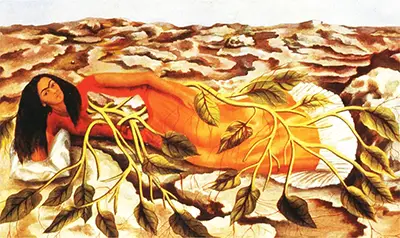Also, the stems of this vine do not have thorns. Rather, they have thirteen leafless stems to depict Kahlo’s losses. Kahlo had lost her father, experienced miscarriages and gone through many operations to repair different areas of her body after the severe accident she went through when she was 19 years. It explains why the vine grows from her womb-less body and moves toward the viewer as if we are the source of hope or light. Frida fixes an impassive gaze on the viewer in a bid to beckon the viewer to confront her predicament.
Most of Frida's self-portraits are an expression of pain, emotional frustration and disappointment. In this painting, she uses an imaginative overtone of symbolism and visionary art to depict her losses, death of loved ones and her inability to sire children. Kahlo criticises her unfortunate state and portrays her sense of guilt in a rather bold way. During this time, Frida had taken to the Surrealist style, though she borrows a few ideas from the traditional Mexican art forms when creating this painting.
Prior to painting Roots, Kahlo had partnered with, Diego, her husband to purchase land in Pedregal, Mexico City. This region was mostly stony, and the Riveras had purchased the property to construct a temple for Diego’s collection of pre-Columbian idols. The couple called it Anahuacali and said it would be a home for Frida and himself during the war. Frida intelligently captures the vast sea of dry, volcanic earth surrounding this temple.
Related Painting - Thinking about Death
This piece clearly shows Kahlo’s state of mind when she created Roots. It was her third self-portrait Kahlo created that year. In this painting, Frida places a skull and bone in a desert landscape on her forehead to accentuate despair, but she also closes the space with a wall of leaves to symbolise life. In the Mexican culture, death meant life and rebirth. It shows Frida understood the fact that death was a different path to another form of life.

